|
Guanajuato Architecture and Historical Sites
Most of the Guanajuato's architecturally significant buildings were built in the Mexican Baroque style because the mines were at their peak production during the 18th century, when this style was fashionable. This style can be found in mansions and civil buildings of that time, but the most ornate examples are churches, with intricate facades and altarpieces both of which often use the “estipite” column (inverted, truncated pyramid).
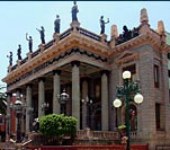
At the beginning of the 19th century, Baroque was giving way to Neoclassical. The Mexican War of Independence ended most major constructions, but in many churches in the state, Baroque altarpieces were replaced with Neoclassical ones. A fine example of Neoclassical architecture is the Teatro Principal in Guanajuato.
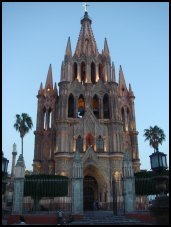
From the 19th century on, trends became more modern with one notable exception. The Parish of San Miguel in San Miguel Allende had its facade redone by self taught architect Zeferino Gutierrez. Working from only images from postcards of Gothic cathedrals in Europe, Gutierrez created the imposing Gothic-like front, which is unique in the state.
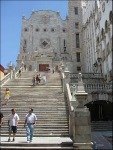
UNIVERSIDAD DE GUANAJUATO (University of Guanajuato). Founded as an orphanage for educational instruction, it became a university in 1945. This edifice of green quarry stone reminds us of the magnificent European medieval designs. Located on Positos Street. Open Tuesday through Saturday from 10:00 AM to 2:00 PM and 4:00 PM to 6:00 PM, and Sunday from 10:00 AM to 3:00 PM.
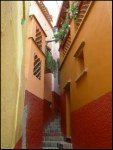
CALLEJON DEL BESO (Alley of the Kiss). In this small narrow alleyway you’ll see several balconies above. Legend has it that two young lovers used to meet here secretly until they were discovered while giving each other a kiss. The father of the young woman allegedly murdered her. According to superstition, visiting couples should plant a kiss on the third step for seven years of happiness. Located in downtown Guanajuato off Avenida Juarez, next to the Plaza de los Angeles.
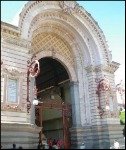
THE HIDALGO MARKET Initially planned as a train station, this main city market was built at the start of the twentieth century and inaugurated in 1910 by President Porfirio Diaz. Its façade is made from pink cantera stone. Inside, you can buy regional candies and crafts. Its architects were Ernesto Brunel and Antonio Rivas Mercado. The original site was the old Gavira bullfighting ring. Construction began in 1905 and was completed on September 16, 1910. The market was inaugurated by President Porfirio Díaz as part of the centennial independence celebrations. The left door of the Mercado leads out to the Gavira market, a traditional Mexican eatery. The opposite door takes one to the Gavira plaza, which is an open-air market.
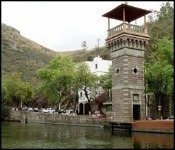
PRESA DE LA OLLA This dam was built in 1749 on the La Olla Ranch. It ceased to operate in 1984 and became one of the city’s most lovely walkways and recreation areas. Located at the southern end of the city along Paseo de la Presa, near the Palacio de Gobierno.
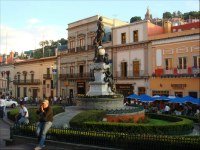
PLAZA DE LA PAZ (Peace plaza) This is the oldest square and perhaps the most important plaza in the city, as it has several houses where famous aristocrats once lived. Here you’ll find many classic colonial buildings, such as the Casas Reales, a former city hall building. Located in the Historic Center on Alonso Street, next to the Presidencia Municipal.
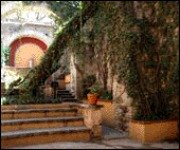
EX-HACIENDA SAN GABRIEL DE BARRERA This 18th-century hacienda with a colonial mansion houses paintings, furniture and rugs from that era. Since 1979, the Ex-Hacienda San Gabriel de Barrera Museum has offered city visitors a place full of greenery and color complemented by magnificent colonial architecture. Originally known as the Ex-Hacienda de Barrera Grande, the hacienda extends over 22,000 square meters (237,000 square ft.). The original entrance was the bridge over the Guanajuato River. The inside of the hacienda is divided into three parts: the first was formerly the house proper, as well as offices and recreational spaces, now all part of the Museum. The second part was where religious services were held. Here, one finds a small chapel featuring a 15th century Spanish altarpiece. The third and last section was a work area, and included areas where the precious ore was extracted, storage rooms, aqueducts, water wheels, tanks, and horse stables. The areas once used in the extraction of ore have been replaced with seventeen beautiful gardens, each one unique. Over the centuries, ownership of the hacienda passed from hand to hand. In 1947, the last private owner, Mrs. Elsa Bas de Armida oversaw the transformation of the old hacienda into what we see today. It was acquired by the Guanajuato State Government in 1975. Located at 89A Paseo la Presa. Open daily from 9:00 to 4:00.
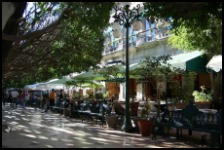
JARDIN UNION Inaugurated in 1861, this small triangular garden has a pavilion from the Porfirian era. It’s a preferred meeting spot among locals. Located between Avenida Cantarranas and Sopeña Street, behind the Templo de Santo Diego.
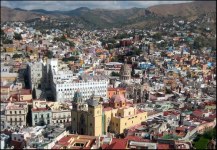
MONUMENTO EL PIPILA (The Pipila Monument) Built in 1939, this monument pays homage to miner Juan Jose Martinez, known as El Pipila, who participated in the struggle for Mexico’s independence. At the monument you’ll get a gorgeous panoramic view of the city.
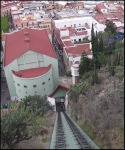
Located on the top of a hill which you can reach by taking the panoramic highway, by foot through alleyways near the Plaza de los Angeles and the Templo de San Francisco or by cog railway from behind the triangular main park known as Jardin Union.
El PipilaJosé de los Reyes Martínez Amaro, an uneducated, indigenous laborer who toiled in the mines of Guanajuato, Mexico was the subject of much ridicule by his fellow workers. They nicknamed him Pipila, which some claim to be a reference to his limping stride while others insist was a reference to his pockmarked face. Further subjecting him to derision, Pipila tied a long slab of rock to his back while he worked in the mines to protect himself from falling debris. Yet that same slab of rock so ridiculed became the device that turned Pipila into a hero of the Mexican War for Independence. Independence sentiments in Guanajuato were running high when Miguel Hidalgo, a priest from the nearby town of Dolores Hidalgo, preached rebellion from the pulpit one Sunday. Mexicans and indigenous Indians in Guanajuato took up the call and attacked the Spanish occupiers, who gathered all the riches they could carry and barricaded themselves inside the Alhondiga de Granaditas, (the Granary), thought to be invincible. The insurgents were repeatedly repulsed by Spanish musketeers firing from their position high atop the grain tower, but just when things were looking bleak, Pipila donned his stone slab, crawled to the wooden door of the granary, covered the door in tar and set it on fire. Once the door of the Alhondiga was breached, the insurgents prevailed due to their massive numbers, massacring everyone inside.
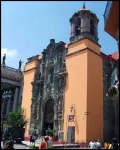
TEMPLO DE SAN DIEGO DE ALCANTARA This pink quarry stone structure is ornamented with Churrigueresque-style sculptures. The church has a valuable collection of 18th-century Mexican art. Open daily from 8:00 AM to 7:00 PM. Located between Sopeña and Alonso streets, next to the Presidencia Municipal.
Return to Guanajuato Main Page
|
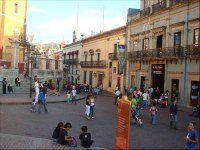
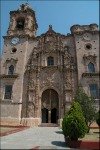
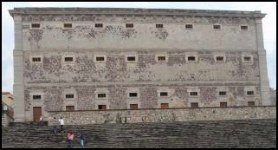
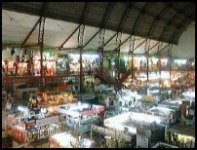
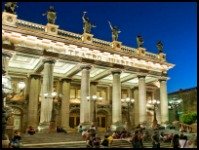
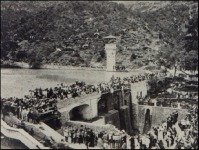
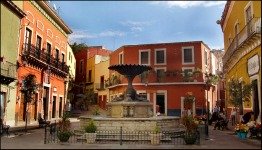
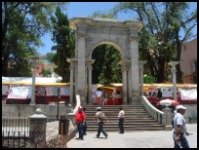
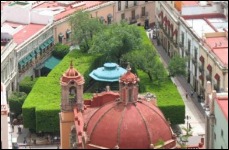
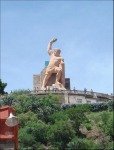
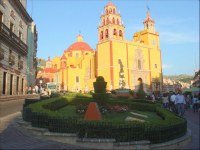 BASILICA DE NUESTRA SENORA DE GUANAJUATO This 1771 pink quarry stone structure blends three styles: 17th-century Baroque, 17th-century Churrigueresque and Neoclassical. Inside is a quilted wooden image of the Virgin of Lourdes, which stands on a magnificent Baroque-style silver pedestal. Located at 7 Ponciano Aguilar Street.
BASILICA DE NUESTRA SENORA DE GUANAJUATO This 1771 pink quarry stone structure blends three styles: 17th-century Baroque, 17th-century Churrigueresque and Neoclassical. Inside is a quilted wooden image of the Virgin of Lourdes, which stands on a magnificent Baroque-style silver pedestal. Located at 7 Ponciano Aguilar Street.


















